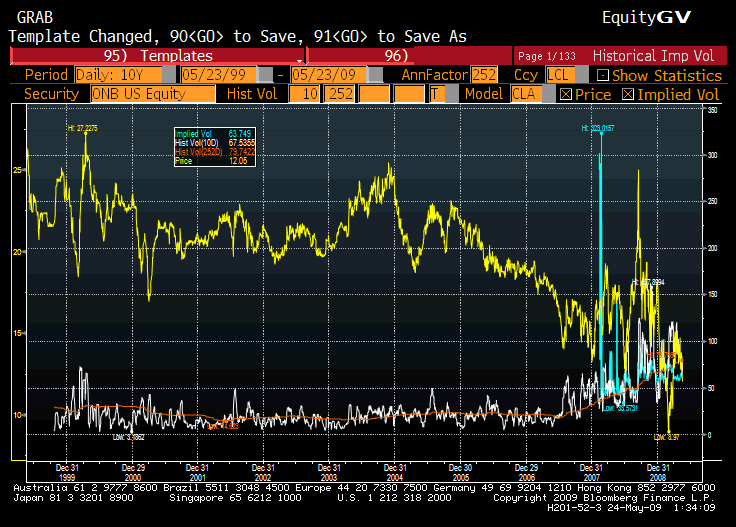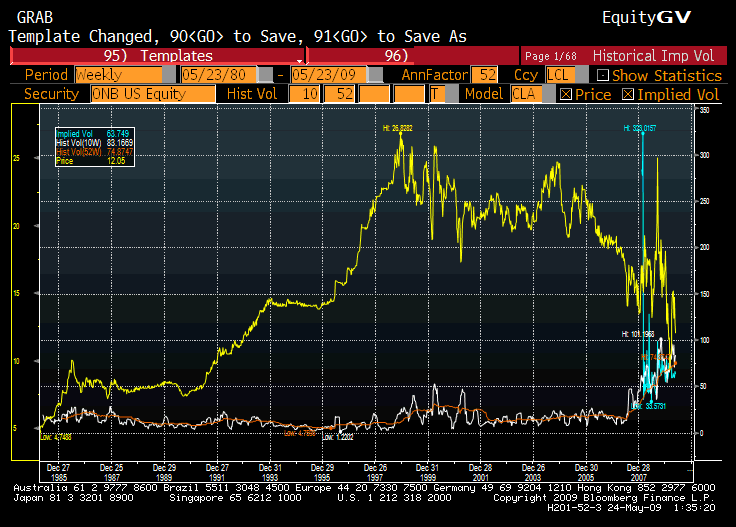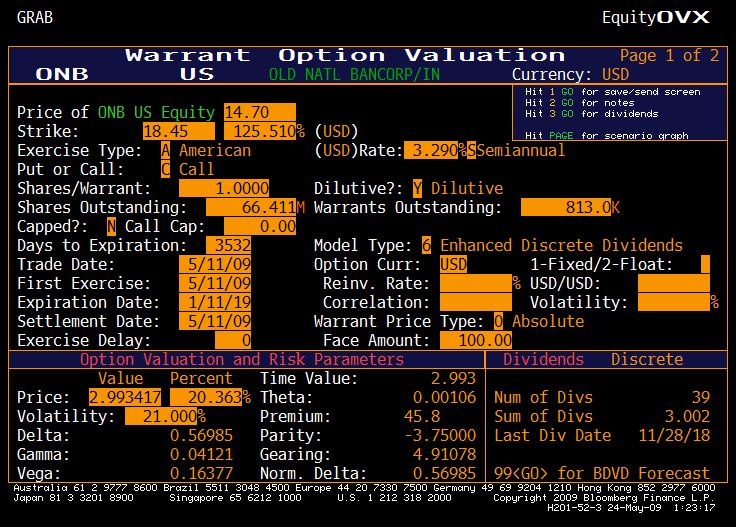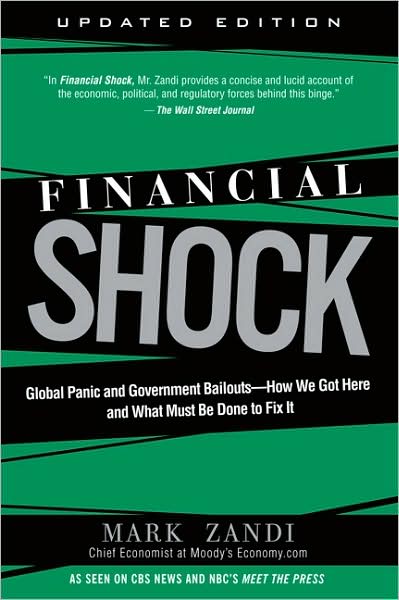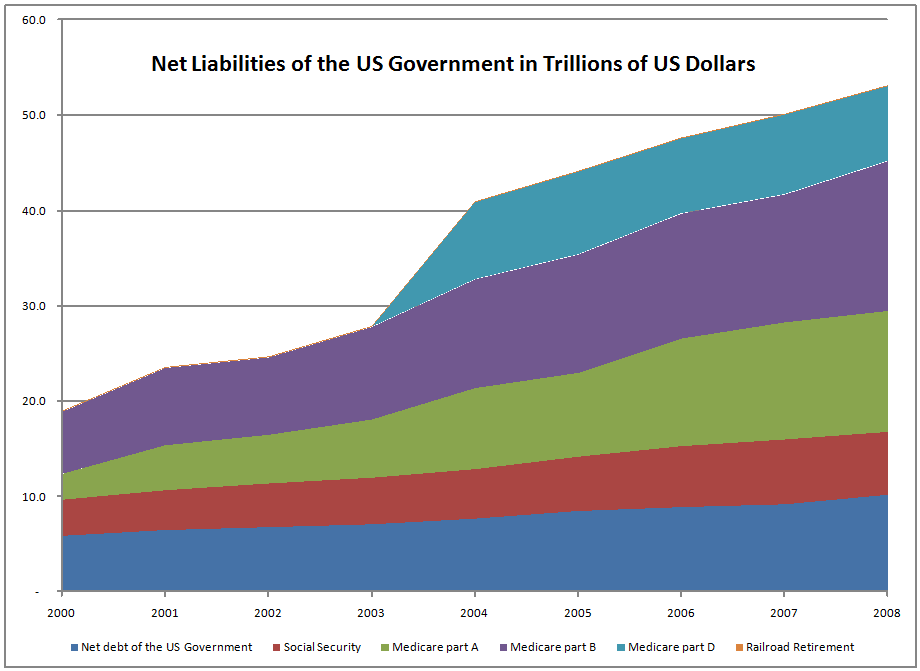The Bump at the end of the Cycle
I haven’t done it recently, but I begin with a bunch of my old CC posts from five years ago:
| |
David Merkel | ||
| Are There Buyers out There for Long Treasuries? | |||
| 5/14/04 8:28 AM?ET |
|||
| I have been arguing for a while that despite a record short interest in Treasury futures, liquidation of the banks leveraged long positions is a bigger factor in the market. The gentle and slow movements of this market have had an upward bias in yield, lower in price. This can be temporarily self-reinforcing, as a rise in rates causes new players to say that they can’t take the pain, and they liquidate long positions.That said, we should begin to see some relief here; the yield curve has only been this steep twice before in the last 22 years, and this is within 5 basis points of the record-wides over that period (the other times were in 1992 and 2003). I would expect buying interest to materialize below 5.00% on the 10-year Treasury note.The yield curve has already built in 125 basis points of tightening, though when it happens is up for grabs. The ultimate amount of tightening will depend on several factors, notably the level of inflation and the occurence of any macroeconomic catastrophes precipitated by the tightening. (Think of the stock market in 1987, solvency of U.S. banks in 1989, Mexico in 1994, LTCM in 1998 and the Nasdaq in 2001… U.S. housing in 2005?)Unless interrupted by a crisis, the ultimate level of tightening will require the short rate (yield on 90-day T-bills) to be at least 100 basis points less in yield than the long rate (the yield on the current long bond). The yield on the long rate will depend more on the anticipated level of inflation. The short rate chases a moving target.Final note: U.S. dollar-denominated liquidity is getting scarcer. One month ago, the yield on three-month LIBOR broke its 200-day moving average. Typically, this doesn’t bode well for financial equities in the short run. Don’t fight the Fed, at least for the first few tightenings.
No stocks mentioned |
|||
and…
| |
David Merkel | ||
| Gradualism means… flexibility?! | |||
| 5/20/04 4:14 PM?ET |
|||
| In Ben Bernanke’s speech, which is going on as I write, he gave three reasons for the Fed to move gradually:1. The Fed does not possess perfect information, so caution is warranted. The Fed learns from the reactions of the real economy and the asset markets, and adjusts its actions. 2. Gradualism gives the Fed greater control over long-term interest rates, and asset prices. 3. Gradualism reduces stress to the financial system. I disagree with his last two points. The Fed does not have much impact on the long end of the yield curve in anything more than the short run. Long rates are affected primarily by the rate of nominal GDP growth in the intermediate term. The Fed reacts to long-term interest rates, and sets the fed funds rate relative to the long rate. Steep curves speed nominal economic activity, and flat curves slow nominal economic activity. As to stress in the financial system, comparisons to the chinese water torture come to mind. While gradualism might be better than drastic moves, gradualism did not prevent the following blowups: bond market (early 87), stock market (late 87), real estate (89-90), Residential MBS and Mexico (94), LTCM and Asia (98), and the Nasdaq (2001-2). Call me a skeptic, but the Fed likes to maximize its own flexibility in applying policy, and gradualism fits that bill. Crises would be better prevented if the Fed stopped trying to fine-tune the economy though over-providing liquidity. Okay, I’m getting off my soap box now… none |
|||
| |
Aaron Task | ||
| Soap Box | |||
| 5/20/04 4:36 PM?ET |
|||
| David, re. this list: bond market (early 87), stock market (late 87), real estate (89-90), Residential MBS and Mexico (94), LTCM and Asia (98), and the Nasdaq (2001-2).Save for the first 2, the rest occurred on Greenspan’s watch. The chairman is often credited for “navigating” us through such crises, but few seem to stop and think about his responsibility (direct or indirect) for their occurrence.Currently, he’s now overseeing a *possible* housing bubble (and corresponding crash in MBS markets). I can’t wait to see how he “navigates” through that.
NOT reassured by his reappointment |
|||
| |
David Merkel | ||
| More on the Bernanke Speech | |||
| 5/20/04 4:50 PM?ET |
|||
| First, a quote from his speech:First, I do agree that the flare-up in inflation in the first quarter is a matter for concern, and that the inflation data bear close watching. Should the rise in inflation show signs of persisting, I am confident that the Federal Open Market Committee will adjust policy as necessary to preserve price stability. As the qualified and probabilistic language of the FOMC’s statement makes clear, the likelihood that the pace of rate normalization will be “measured” represents a forecast about the future evolution of policy, not an unconditional commitment on the part of the Committee. Although I expect policy to follow the usual gradualist pattern, the pace of tightening will of necessity respond to evolving economic conditions, particularly the strength of the ongoing recovery in the labor market and developments on the inflation front.Measured may not be as gradual as one might expect. The fed wants to keep its options open. Though Mr. Bernanke says that he wants Fed policy to be transparent to the markets, the flexibility needed to respond to changing conditions makes the predictability of Fed actions difficult over anything longer than a few months.Bernanke did give us a peek at the neutral Fed funds rate. He believes that it is 2.7% over inflation. If the Fed has an inflation target of 1-2%, that gives a neutral fed funds rate of 3.7-4.7%. He added that the neutral fed funds rate changes with economic conditions, which was another argument for gradualism.
If the Fed is eventually aiming at a 4% fed funds rate, and they do 50 basis points each time they tighten (aggressive assumption) that would augur for six tightenings, assuming that a crisis doesn’t interrupt their activities. Who is ready for six tightening moves out to the end of 2005? I think most market participants are expecting less. none |
|||
| |
David Merkel | ||
| At Least the Price of Soap Boxes isn’t Going Up | |||
| 5/20/04 5:05 PM?ET |
|||
| Aaron, I agree with you. In some ways, I think Greenspan was shaped by his initial reaction to the stock market crash in 1987. He threw liquidity at the problem and it went away, or so it seemed. The banks became flush with money to lend, and they lent badly on real estate, which helped to drive the next crisis.Greenspan, having moved far from his earlier Ayn Rand-leanings, and his early devotion to the gold standard, became an inveterate policy tinkerer once in power. Do I blame him? A little; many of us do less well than we would have expected when more power comes into our hands. Greenspan is no exception there.But creating and responding to crises is not unique to Alan Greenspan. At the tight points of monetary policy, crises pop out. Here are a few more from Volcker’s term: Continental Illinois (1984), and third world debt (early 80s). There were other crises correlated with monetary policy before that, but the leverage wasn’t as high, unless you go back to the 1920s. By its very nature, tight monetary policy reveals the places in the economy that have insufficient financial flexibility. The question I have, is where that inflexibility exists today.
none |
|||
-==-=-=-=–=-==-=-=-=-=-=–=-=-=-==–=-==–==-=-=-=-=-
Well, here we are on the other side of the interest rate cycle.? Rates are not being tightened, but rather, they have been loosened to the point where they are irrelevant.? “Credit Easing” monopolizes liquidity for the favored markets that the Fed wants to heal, while other credit markets go begging.
Monetary policy is loose, and as I have stated before, loose monetary policy typically ends in some excess, whether that excess is goods price inflation, or asset inflation, or perhaps a currency panic, where foreign creditors conclude that they will not get paid back in anything near the terms that they expected when they originally lent.
So, what might be the end of this cycle?? Here are some possibilities:
- A slow rise of interest rates in the US, as smaller foreign central banks decide that they have better opportunities elsewhere, and stop buying additional US dollar-denominated liabilities.
- A major global war interrupts everything, disrupting global trade and capital flows, and forcing the US to largely self-fund its obligations, all the while spending more on defense.
- Goods inflation runs, starting with commodity prices, as the rest of the world, excluding the US and Europe, heals faster.
There are many more variations on the scenarios here, but these give an idea of the forces that may undermine the current quietude.


